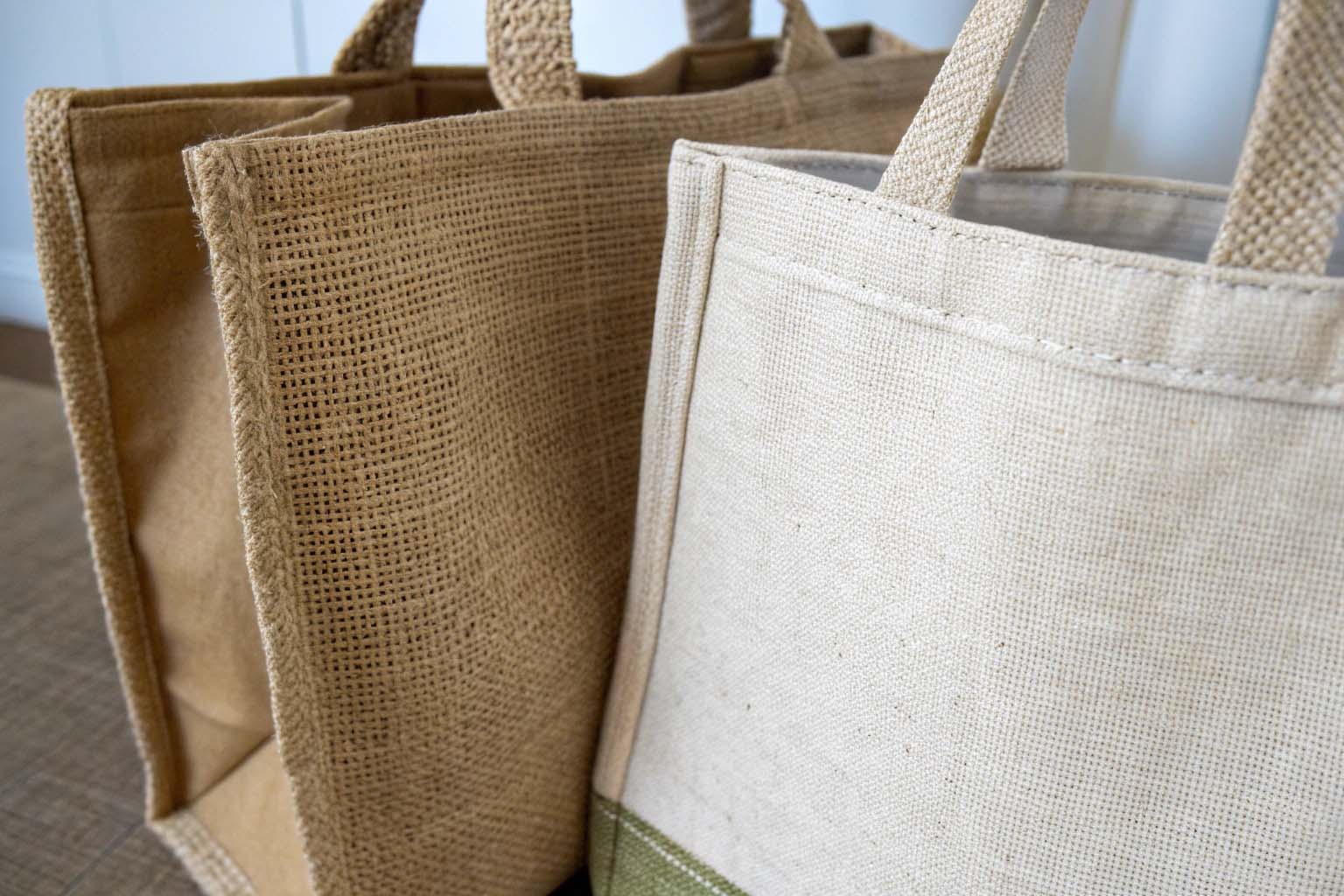Tired of reusable bags tearing under pressure? It’s frustrating when bags fail, especially with heavy loads. Choosing the right material from the start solves this problem.
The best materials for heavy-duty reusable bags balance strength, durability, and sometimes eco-friendliness. Top choices include heavy cotton canvas, durable jute, strong synthetic Oxford fabric, and resilient rPET made from recycled plastics. The ideal material depends on your specific carrying needs and priorities.
Choosing the right bag isn’t just about picking a material; it’s about ensuring it performs reliably time after time. You need confidence that your bag can handle the job, whether it’s for groceries, promotional events, or industrial use. Let’s explore the options so you can make an informed decision and avoid the disappointment of a bag that gives way when you need it most. Understanding the nuances of each material will help you source bags that truly meet your heavy-duty requirements.
What specific bag types and materials are best suited for carrying heavy goods?
Need bags that won’t buckle under heavy groceries or supplies? Worrying about handles ripping or seams splitting is stressful. Specific designs combined with robust materials are the answer.
Gusseted tote bags made from heavy-gauge cotton canvas (10oz+), jute, or high-denier synthetics like 600D Oxford fabric are ideal for heavy goods. Reinforced handles (cross-stitched) and sturdy construction significantly enhance carrying capacity and durability.
When clients ask me about bags for seriously heavy items, I always look at two things: the material and the construction. It’s not enough to just have a strong fabric; the bag itself needs to be built to handle the stress.
Understanding Bag Construction for Strength
- Gussets: These are panels added to the sides and/or bottom of a bag. They expand the bag’s capacity and, more importantly, distribute the weight more evenly across the base and sides. This reduces strain on any single seam. A full gusset (bottom and sides) offers the most volume and support.
- Reinforced Handles: This is critical. Look for handles with reinforced stitching, often in an ‘X’ pattern (cross-stitching) where the handle meets the bag body. This drastically increases the tear strength at these high-stress points. Handle material matters too; using the same heavy fabric or strong webbing adds to the resilience.
- Stitching: Seams should be tightly stitched, potentially double-stitched, especially along the bottom and gussets. Quality thread makes a difference here too.
Matching Construction with Materials
Combining these construction features with the right materials creates a truly heavy-duty bag. Imagine a 12oz canvas tote with wide, cross-stitched handles and a bottom gusset – that’s a bag built to last and carry significant weight. Similarly, a 600D Oxford bag with these features offers incredible strength plus water resistance. Jute bags, while naturally rugged, also benefit immensely from reinforced handles and gussets for heavy loads.
How does cotton canvas compare to jute for heavy-duty tote bag strength?
Choosing between natural fibers like cotton et jute? It’s tough when both seem strong, but they have key differences. Understanding these helps you pick the best for your specific needs.
Heavyweight cotton canvas (e.g., 12oz, 16oz) generally provides higher tensile strength and a smoother surface than standard jute. However, jute is known for its ruggedness, coarse texture, and excellent durability, especially against abrasion, making it very effective for heavy-duty use.

In my years sourcing bags, I’ve handled countless canvas and jute options. Both are fantastic sustainable choices for heavy-duty applications, but they excel in slightly different ways.
Canvas: Smooth Strength
Coton canvas strength comes from its tight weave. The weight, measured in ounces per square yard (oz) or grams per square meter (GSM), is a key indicator.
- Lightweight Canvas (4-8 oz): Good for basic totes, but not truly heavy-duty.
- Medium-weight Canvas (10-12 oz): The sweet spot for many reusable bags – strong, durable, good structure. Excellent for most heavy-duty needs.
- Heavyweight Canvas (14 oz+): Extremely durable, stiff, used for tool bags or very demanding applications.
Canvas offers a smoother printing surface, which is often a plus for branding. Its primary strength is resisting pulling forces (tensile strength).Jute: Rugged Durability
Jute fibers are naturally thick and coarse, giving the fabric its characteristic rough texture and exceptional sturdiness.
- Natural Resilience: Jute holds up well to rough handling and abrasion. Think potato sacks – they’re traditionally jute for a reason!
- Respirabilité : Jute is more breathable than tightly woven canvas.
- Éco-crédits : Jute requires less water and pesticides to grow than conventional cotton, boosting its eco-friendly profile.
While perhaps not having the same tensile strength rating as very heavy canvas, jute’s overall ruggedness makes it a heavy-duty champion. The choice often comes down to the desired feel, look, and specific type of stress the bag will endure. For sheer carrying capacity, a heavy canvas might edge it out slightly, but for overall toughness and eco-friendliness, jute is hard to beat.Are HDPE (High-Density Polyethylene) bags a viable option for heavy-duty needs?
Considering plastic-based bags for heavy loads? HDPE sounds industrial, but is it a practical choice? It’s strong, yes, but sustainability is a major concern for many brands today.
HDPE woven bags (similar to PP woven) are extremely strong, tear-resistant, water-resistant, and cost-effective, making them technically suitable for heavy-duty tasks like carrying sand or bulk goods. However, their plastic origin raises significant environmental concerns compared to natural or recycled fibers.

When we talk about heavy-duty bags, sometimes clients mention options like those tough, shiny woven bags often used for rice, feed, or construction materials. These are typically made from PP (Polypropylene) Woven fabric, but HDPE (High-Density Polyethylene) can be used similarly and offers comparable properties.
The Pros of HDPE/PP Woven Bags
- Exceptional Strength: Woven plastic fabrics have incredible tensile strength and puncture resistance. They are designed to hold substantial weight without tearing.
- Water Resistance: Plastic doesn’t absorb water, protecting contents from moisture. Lamination can make them fully waterproof.
- Cost-Effectiveness: Mass production makes these bags very inexpensive, especially at large volumes.
- Durability: They withstand rough handling and multiple uses, though they can degrade with UV exposure over time.
The Cons: Sustainability and Perception
The big drawback is environmental. While technically reusable and sometimes recyclable (depending on local facilities and whether they are laminated), they are still virgin plastics.
- Fossil Fuel Origin: Made from non-renewable resources.
- End-of-Life Issues: Often end up in landfills or as environmental pollutants. Recycling infrastructure isn’t universal.
- Brand Image: For businesses focused on sustainability (like many I work with), opting for virgin plastic, even if durable, can clash with their brand values and customer expectations.
So, while HDPE/PP woven bags sont a viable heavy-duty option from a purely functional standpoint, especially for industrial or bulk transport, they are generally less preferred for consumer-facing reusable bags where eco-friendliness is a priority. Natural fibers or recycled options usually align better with sustainability goals.Besides jute and canvas, what other fabrics offer heavy-duty performance? (e.g., Oxford, rPET)
Think heavy-duty stops at canvas and jute? Many clients are surprised by other excellent options available. Synthetics like Oxford and recycled materials like rPET offer unique advantages.
Oxford fabric, typically polyester or nylon with a specific basket weave, offers high durability and water resistance (especially coated). rPET fabric, made from recycled plastic bottles, provides a strong, sustainable alternative with good strength, comparable in feel to polyester.

While I often recommend canvas and jute for their natural appeal and strength, sometimes a project calls for different properties. That’s where materials like Oxford and rPET come in. I’ve sourced many bags using these, and they perform exceptionally well for heavy-duty applications.
Oxford Fabric: The Durable Synthetic
- What it is: Oxford is usually made from polyester or nylon, characterized by its basket weave structure. This weave enhances durability and tear resistance.
- Denier Count: Denier Count: Its strength is often indicated by a Denier count1, like 300D, 600D, or even higher. 600D Polyester Oxfor is a common choice for durable backpacks, luggage, and heavy-duty promotional bags. It offers a great balance of strength, weight, and cost.
- Avantages : High abrasion resistance, good tensile strength, often water-resistant or easily coated (e.g., PVC, PU) for waterproofing. It also takes printing well.
rPET Fabric: The Sustainable Powerhouse
- What it is: rPET stands for Recycled Polyethylene Terephthalate. It’s a polyester fabric made from recycled plastic items, primarily water bottles.
- Eco-Friendly Strength: Making fabric from recycled materials reduces landfill waste and dependence on virgin resources. Importantly, rPET doesn’t sacrifice strength. It can be produced in various weights and weaves, creating fabrics strong enough for heavy-duty bags. Its durability is similar to virgin polyester.
- Feel and Look: Good quality rPET fabric2 feels very similar to standard polyester. It can be woven or non-woven, and it’s suitable for printing and various bag designs. Using rPET often comes with certifications (like GRS – Global Recycled Standard3) that verify the recycled content, adding credibility to sustainability claims.
Both Oxford and rPET expand the toolkit for creating robust, long-lasting reusable bags tailored to specific performance needs and environmental goals.
Both Oxford and rPET expand the toolkit for creating robust, long-lasting reusable bags tailored to specific performance needs and environmental goals.
What defines a fabric as "heavy-duty" for bag manufacturing purposes?
Heard the term "heavy-duty" but wonder what it really means? It’s not just a label; specific technical qualities make a fabric truly robust. Understanding these helps avoid weak bags.
A "heavy-duty" fabric for bags possesses high tensile strength, tear resistance, and abrasion resistance. Key indicators include material weight (GSM for natural fibers, Denier for synthetics), dense weave structure, fiber thickness, and the inherent properties of the material itself (e.g., canvas, jute, high-denier polyester).

Defining "heavy-duty" is crucial when I’m specifying materials for clients who need reliable bags. It boils down to a fabric’s ability to withstand stress without failing. Here’s how I break it down:
Key Metrics for Heavy-Duty Fabrics:
- Material Weight/Thickness: This is often the first indicator.
- Natural Fibers (Canvas, Jute): Measured in Grams per Square Meter (GSM) or Ounces per Square Yard (oz). Higher numbers mean more material and generally greater strength. For canvas, anything above 270 GSM (approx. 8 oz) starts moving towards medium/heavy duty, with 340 GSM (10 oz) and up being solidly heavy-duty.
- Synthetic Fibers (Polyester, Nylon): Measured in Denier (D). Denier relates to the thickness/weight of the individual threads. Common heavy-duty ratings are 600D or 900D. Higher denier generally equals stronger fabric.
- Weave Density and Type: A tighter, denser weave increases strength and resistance to tearing and abrasion. Specific weaves like canvas (plain weave), twill, or Oxford (basket weave) contribute to durability.
- Tensile Strength: The amount of force required to pull the fabric apart. Heavy-duty fabrics have high tensile strength.
- Tear Resistance: How well the fabric resists ripping or tearing once a small cut or puncture has started.
- Abrasion Resistance: The fabric’s ability to withstand rubbing and friction without wearing through.
| Fonctionnalité | Indicator | Example (Heavy-Duty) | Notes |
|---|---|---|---|
| Poids | GSM (natural) / Oz (natural) | >340 GSM / >10 oz Canvas | Higher value = generally stronger |
| Poids | Denier (synthetic) | 600D+ Polyester/Nylon | Measures thread thickness/weight |
| Weave | Density / Type | Tight Plain/Twill/Oxford | Affects tear & abrasion resistance |
| Matériau | Fiber Type | Cotton Canvas, Jute, PET | Inherent properties contribute strength |
| Construction | Stitching, Handles | Reinforced, Cross-stitch | Bag design complements fabric strength |
Ultimately, a "heavy-duty" designation means the fabric, combined with appropriate bag construction, is reliably strong enough for demanding carrying tasks over a long period. As highlighted in my insights, heavy canvas and Oxford often hit that sweet spot of performance and cost-effectiveness.
Conclusion
Choosing the best heavy-duty bag material involves balancing strength, cost, appearance, and eco-impact. Canvas, jute, Oxford, and rPET are all strong contenders depending on your specific needs and priorities.
-
Understanding Denier count helps in choosing the right fabric for durability and strength in products like bags. ↩
-
Explore this link to understand the advantages of rPET fabric, its applications, and how it contributes to sustainability. ↩
-
Learn about the Global Recycled Standard to see how it ensures the credibility of recycled materials in products. ↩


